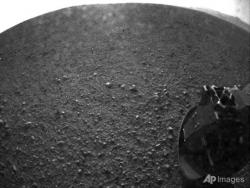Search the Community
Showing results for tags 'nasa'.
-
https://www.businessinsider.com/nasa-engineers-puzzled-by-mysterious-signals-from-voyager-1-2022-5 NASA said Voyager 1 is sending data that doesn't match the spacecraft's movements. The veteran spacecraft has been exploring our solar system and interstellar space since 1977. It is now 14.5 billion miles away from Earth, making it the most distant human-made object. NASA's Voyager 1 is continuing its journey beyond our solar system, 45 years after it was launched. But now the veteran spacecraft is sending back strange data, puzzling its engineers. NASA said on Wednesday that while the probe is still operating properly, readouts from its attitude articulation and control system — AACS for short — don't seem to match the spacecraft's movements and orientation, suggesting the craft is confused about its location in space. The AACS is essential for Voyager to send NASA data about its surrounding interstellar environment as it keeps the craft's antenna pointing right at our planet. "A mystery like this is sort of par for the course at this stage of the Voyager mission," Suzanne Dodd, a project manager for Voyager 1 and 2 at NASA's Jet Propulsion Laboratory, said in a statement. "The spacecraft are both almost 45 years old, which is far beyond what the mission planners anticipated." NASA said Voyager 1's twin, the Voyager 2 probe, is behaving normally. Launched in 1977 to explore the outer planets in our solar system, Voyager 1 has remained operational long past expectations and continues to send information about its journeys back to Earth. The trailblazing craft left our solar system and entered interstellar space in 2012. It is now 14.5 billion miles away from Earth, making it the most distant human-made object. NASA said that from what its engineers can tell, Voyager 1's AACS is sending randomly generated data that does not "reflect what's actually happening onboard." But even if system data suggests otherwise, the spacecraft's antenna seems to be properly aligned — it is receiving and executing commands from NASA and sending data back to Earth. It said that so far the system issue hasn't triggered the aging spacecraft to go into "safe mode," during which it carries out only essential operations. "Until the nature of the issue is better understood, the team cannot anticipate whether this might affect how long the spacecraft can collect and transmit science data," NASA said. Dodd and her team hope to figure out what's prompting the robot emissary from Earth to send junky data. "There are some big challenges for the engineering team," Dodd said. A major one: It takes light 20 hours and 33 minutes to get to Voyager's current interstellar location, so a round-trip message between the space agency and Voyager takes two days. "But I think if there's a way to solve this issue with the AACS, our team will find it," Dodd added.
-
From CNA: http://www.channelnewsasia.com/stories/afp...1238785/1/.html Life on Mars? Maybe not: NASA Posted: 22 November 2012 0755 hrs In this photo provided by NASA's JPL, this is one of the first images taken by NASA's Curiosity rover, which landed on Mars on August 6 (AP Photo/NASA/JPL-Caltech) WASHINGTON: NASA downplayed Wednesday talk of a major discovery by its Martian rover after remarks by the mission chief raised hopes it may have unearthed evidence life once existed on the Red Planet. Excitement is building over soon-to-be-released results from NASA's Curiosity rover, which is three months into a two-year mission to determine if Mars has ever been capable of supporting microbial life. Its Sample Analysis at Mars (SAM) instruments have been sending back information as it hunts for compounds such as methane, as well as hydrogen, oxygen and nitrogen, that would mean life could once have existed there. In an interview with US broadcaster National Public Radio, aired Tuesday, lead mission investigator John Grotzinger hinted at something major but said there would be no announcement for several weeks. "We're getting data from SAM," he said. "This data is gonna be one for the history books. It's looking really good." A spokesman for NASA's Jet Propulsion Laboratory, which is managing the project, appeared to pour cold water Wednesday on the hopes of space enthusiasts looking forward to an earth-shattering discovery. "John was delighted about the quality and range of information coming in from SAM during the day a reporter happened to be sitting in John's office last week. He has been similarly delighted by results at other points during the mission so far," spokesman Guy Webster told AFP. "The scientists want to gain confidence in the findings before taking them outside of the science team. As for history books, the whole mission is for the history books," Webster said. Scientists do not expect Curiosity to find aliens or living creatures but they hope to use it to analyze soil and rocks for signs the building blocks of life are present and may have supported life in the past. The $2.5 billion Curiosity rover -- which landed in Gale Crater on the Red Planet on August 6 -- also aims to study the Martian environment to prepare for a possible human mission there in the coming years. US President Barack Obama has vowed to send humans to the planet by 2030. - AFP/fa
-
Surprised that nobody posted this: http://www.bbc.com/news/science-environment-33524589 New Horizons: Nasa spacecraft speeds past Pluto Nasa's New Horizons spacecraft has made the first visit to Pluto, speeding past at 14km per second. Earlier, the space agency released the most detailed picture yet as it hurtled towards the dwarf planet on Tuesday. The probe was set to grab more pictures and other data as it passed 12,500km from Pluto at 11:50 GMT (12:50 BST). Controllers got a last health status report, before the robotic craft turned its antenna away from the Earth to concentrate on its target. We have completed the initial reconnaissance of the Solar System Alan Stern, New Horizons chief scientist Only when New Horizons has its trove of images safely in its onboard memory will it call home again. This is not expected to happen until just after midnight (GMT) into Wednesday. It means there will be a long, anxious wait for everyone connected with the mission, as they hold out for a signal that will be coming from almost five billion km away. But scientists already have colour data from the approach and said they might release a new picture later on Tuesday. Images set to be released on Wednesday will be more than 10 times the resolution of those already published. New Horizons' flyby of 2,370km-wide Pluto is a key moment in the history of space exploration.
-
from Yahoo : NASA: The world will not end on December 21, 2012 AFP Relax
-
Nasa's Dawn probe bears down on CeresThe US space agency is waiting for confirmation that its Dawn probe has gone into orbit around Ceres, the largest object in the asteroid belt between Mars and Jupiter. It has taken the satellite 7.5 years to reach its destination, and it will spend the next 14 months mapping the diminutive world. Ceres is the first of the dwarf planets to be visited by a spacecraft. http://www.bbc.com/news/science-environment-31754586
-
Read in Yahoo News : NASA radar finds ice on moon's north pole WASHINGTON (AFP) -










